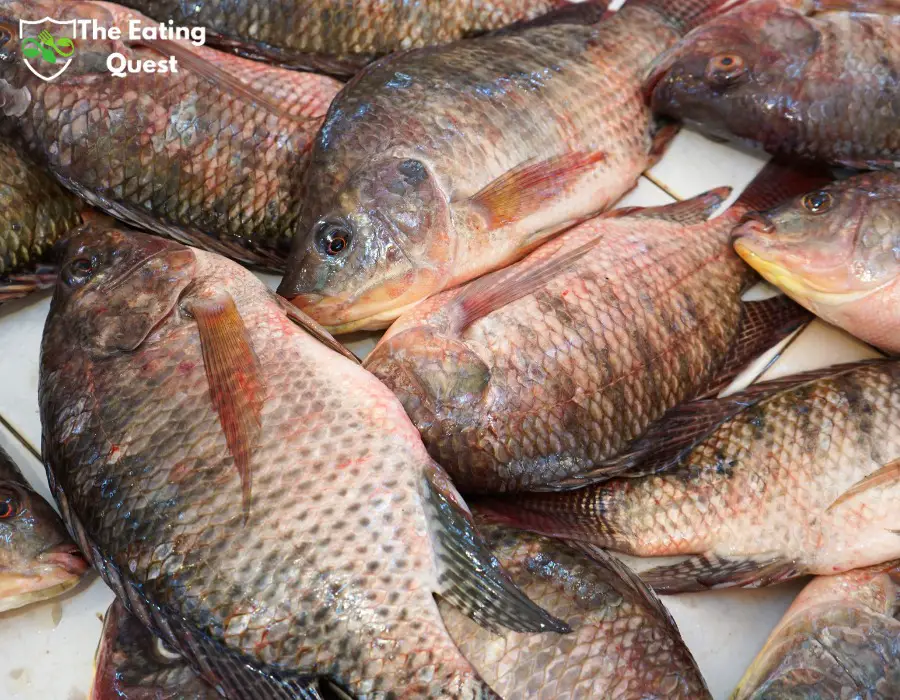If you’re a fan of tilapia, it’s important to know How Long Does Tilapia Last in the Fridge before it goes bad. Proper storage of food is critical to preventing foodborne illnesses. Tilapia is a popular white fish widely available in the United States and often used in many seafood recipes. So, how long does tilapia last in the fridge?
According to the FDA, raw tilapia can be stored in the refrigerator for up to 2 weeks at a temperature of 40°F or below. However, to ensure that your tilapia stays fresh and safe to eat, it’s best to consume it within two days of refrigeration. Conversely, cooked tilapia can last up to four days in the fridge if stored properly.
What is Tilapia?
Tilapia is a freshwater fish that is widely consumed around the world. It is a white, lean fish that is low in fat and protein. Tilapia is often farmed, making it a readily available and affordable option for consumers.
Tilapia is a member of the cichlid family, a diverse group of fish found in freshwater habitats. There are over 100 species, but the Nile tilapia is the most commonly consumed.
Tilapia is known for its mild flavor and versatility in cooking. It can be baked, grilled, fried, or sautéed and pairs well with various seasonings and sauces.
Regarding nutrition, tilapia is a good source of protein, vitamins, and minerals. A 3.5-ounce serving of tilapia contains approximately 26 grams of protein and significant amounts of vitamin B12, selenium, and phosphorus.
Overall, tilapia is a healthy and delicious option for those looking to incorporate more fish into their diet. When stored properly, tilapia can last several days in the fridge, making it a convenient meal prep and planning option.
How Long Does Tilapia Last in the Fridge?
If you enjoy eating tilapia, knowing how long it lasts in the fridge is essential to avoid food waste and potential health risks. Here’s what you need to know about tilapia’s shelf life in the refrigerator.
-
Raw Tilapia
Raw tilapia should be stored in the fridge at a temperature of 40°F or below. At this temperature, it can last for up to 2 days. After that, it’s best to discard it as it can become a breeding ground for bacteria that can cause food poisoning.
-
Cooked Tilapia
Cooked tilapia can last longer than raw tilapia in the fridge. When stored correctly at 40°F or below, cooked tilapia lasts up to 4 days. If you want to extend its shelf life, you can freeze it, where it can last for up to four months.
Signs of Spoilage
It’s essential to watch for signs of spoilage when storing tilapia in the fridge. If you notice any of the following signs, it’s best to discard the fish:
- Foul odor
- Slimy texture
- Discolouration
- Mold growth
Proper Storage
Proper storage is crucial to ensure that tilapia lasts as long as possible in the fridge. Here are some tips for storing tilapia:
- Please keep it in an airtight container or wrapped tightly in plastic to prevent air exposure.
- Store it on the fridge’s bottom shelf to prevent juices from dripping onto other foods.
- Avoid storing it at room temperature for an extended period, which can cause bacteria growth.
In summary, tilapia can last up to 2 days in the raw fridge and up to 4 days when cooked. It’s essential to store it correctly and keep an eye out for signs of spoilage to avoid any potential health risks.
How Long Does Tilapia Last in the Freezer?
If you have a lot of tilapia on hand, freezing it is a great way to make it last longer. Properly frozen tilapia can last for several months in the freezer. Here’s what you need to know about freezing tilapia:
- Freezing raw tilapia: When freezing raw tilapia, it’s important to wrap it tightly to prevent freezer burn. You can wrap it in plastic or aluminium foil or a freezer-safe bag. Remove as much air as possible from the packaging before sealing it. Properly frozen raw tilapia can last up to 8 months in the freezer.
- Freezing cooked tilapia: If you have leftover cooked tilapia, you can freeze it to enjoy later. Cooked tilapia should be cooled to room temperature before freezing. You can wrap it in plastic or aluminium foil or a freezer-safe bag. Properly frozen cooked tilapia can last up to 3 months in the freezer.
- Vacuum sealing tilapia: If you want to extend the shelf life of your frozen tilapia, consider vacuum sealing it. Vacuum-sealed tilapia can last for up to 1 year in the freezer.
It’s important to note that the texture of frozen tilapia may change slightly once it’s been frozen and thawed. However, the changes should be minimal if you freeze and thaw your tilapia properly.
Always thaw frozen tilapia in the refrigerator or under cold running water. Never thaw it at room temperature, as this can promote the growth of harmful bacteria.
In the United States, keeping your freezer at 0°F or below is recommended to ensure the safety and quality of your frozen seafood. If your freezer is not at the proper temperature, your tilapia may not last as long.
Proper storage of tilapia in the freezer can help you save money and reduce waste. Following these guidelines, you can enjoy delicious tilapia for months.
How to Store Tilapia
When storing tilapia, following some basic guidelines is important to ensure that the fish stays fresh and safe to eat. Here are some tips on how to store tilapia properly:
Storing Raw Tilapia
If you have raw tilapia that you want to store in the fridge, keep it in an airtight container or wrapped tightly in plastic wrap. This will help prevent air and moisture from getting in and spoiling the fish. You can also store it in a freezer bag if you freeze it.
It’s important to keep the temperature of your fridge at 32°F (0°C) or below to prevent bacteria growth. Raw tilapia can be stored in the fridge for up to 2 days, but it’s best to cook it as soon as possible for optimal quality.
Storing Cooked Tilapia
Cooked tilapia can be stored in the fridge for up to 4 days. Make sure to put it in an airtight container or wrap it tightly in plastic to prevent air and moisture from getting in. You can also store it in a freezer bag if you freeze it.
Let the cooked tilapia cool to room temperature before putting it in the fridge. Putting hot food in the fridge can raise the temperature and cause other foods to spoil. Once cooled, put the tilapia in the fridge as soon as possible.
Freezing Tilapia
If you want to store tilapia longer, you can freeze it. Raw tilapia can be frozen for 6-8 months, while cooked tilapia can be frozen for 2-3 months.
To freeze tilapia, wrap it tightly in plastic, airtight containers, or freezer bags. Label the container with the date and type of fish so you know when to use it.
Other Tips
Here are some other tips to keep in mind when storing tilapia:
- Always store tilapia in the fridge or freezer. Leaving it out at room temperature can cause bacteria growth and spoilage.
- Ensure your fridge is set to the proper temperature (32°F or below) to prevent bacteria growth.
- Discard the fish immediately if you notice any spoilage (such as a foul odor, slimy texture, or discoloration).
- Always wash your hands and any utensils or surfaces that come into contact with the tilapia to prevent cross-contamination.
- When thawing frozen tilapia, do so in the fridge or under cold running water. Never thaw it at room temperature.
By following these guidelines, you can ensure that your tilapia stays fresh and safe to eat for as long as possible.

How to Tell if Tilapia Is Bad?
When it comes to tilapia, it’s important to know when to throw it out. Consuming bad tilapia can lead to foodborne illnesses, which can be dangerous. Here are some signs to look for to tell if your tilapia has gone bad.
Smell
One of the first signs of bad tilapia is a sour smell. If your tilapia smells sour or has a strong, unpleasant odor, it’s likely gone bad. A fishy smell is normal for fresh tilapia, but if it smells overly fishy or pungent, it’s best to discard it.
Appearance
The appearance of tilapia is another important factor to consider. Fresh tilapia should have a bright, shiny appearance with clear eyes and red gills. If the gills are brown or gray, it’s a sign that the fish is no longer fresh. Additionally, if the color of the tilapia is dull or gray, it’s likely gone bad.
Texture
The texture of tilapia is also an important factor to consider. Fresh tilapia should be firm to the touch, with moist flesh. If the flesh is dry or slimy, it’s a sign that the fish is no longer fresh. Additionally, if there is any mold present on the tilapia, it should be discarded immediately.
It’s important to note that contamination can also be a factor in determining if tilapia is bad. If your tilapia has been exposed to moisture or stored improperly, it will likely go bad quickly. Always properly store your tilapia in the refrigerator below 40 degrees Fahrenheit and consume it within 1-2 days.
In summary, to determine if your tilapia is bad, look for signs of a sour smell, off-color or dull appearance, and dry or slimy texture. If you notice any of these signs, it’s best to discard the tilapia to avoid the risk of foodborne illnesses.
How to Cook Tilapia
Cooking tilapia is a simple and delicious way to enjoy this popular fish. There are many ways to prepare tilapia, including baking, steaming, and frying. Here are some easy and tasty recipes to try at home.
Baked Tilapia
Baked tilapia is a healthy and flavorful option for those who prefer a lighter meal. To prepare:
- Preheat your oven to 450°F and lightly grease a baking dish with cooking spray.
- Rinse the tilapia fillets under cold water and pat dry with a paper towel.
- Place the fillets in the baking dish and season with salt, pepper, and your favorite herbs and spices.
- Bake for 10-15 minutes until the fish is cooked and flakes easily with a fork.
Steamed Tilapia
Steamed tilapia is another healthy and easy option that preserves the fish’s natural flavours. To prepare:
- Fill a large pot with a few inches of water and boil.
- Place a steamer basket or colander over the pot and add the tilapia fillets.
- Cover with a lid and steam for 8-10 minutes or until the fish is cooked and opaque.
Fried Tilapia
Fried tilapia is a popular way to enjoy this fish in many cultures. Prepare a few tablespoons of oil in a large skillet over medium-high heat. Rinse the tilapia fillets under cold water and pat dry with a paper towel. Season with salt, pepper, and your favorite spices. Dredge the fillets in flour or cornmeal and shake off any excess. Fry the fillets for 3-4 minutes per side until golden brown and crispy.
No matter how you cook your tilapia, it’s important to handle it properly to ensure it stays fresh and safe to eat. Always store your tilapia in the refrigerator at 40°F or below and use it within 2-3 days of purchase. When reheating cooked tilapia, ensure it reaches an internal temperature of 165°F to kill bacteria. Enjoy your delicious and healthy tilapia meal!
Conclusion
In conclusion, it is important to properly store tilapia to ensure its freshness and safety for consumption. Here are some key takeaways:
- Tilapia will last about 1-4 days in the refrigerator if stored properly.
- Keeping tilapia at 40 degrees Fahrenheit (4.4 degrees Celsius) or below is best to ensure freshness.
- Cooked tilapia lasts longer in the fridge, up to 4 days.
- Raw tilapia can be stored in the freezer for 6 to 8 months. It should be stored in airtight, freezer-safe containers to prevent freezer burn.
- Once thawed, tilapia should not be kept in the refrigerator for more than two days.
It is important to note that the duration of tilapia’s freshness can vary depending on the condition of the fish and how it was stored. To ensure the safety of your food, it is always best to follow proper food safety guidelines and use your best judgment when it comes to consuming food that has been stored for an extended period.
Properly storing your tilapia allows you to enjoy this delicious and nutritious fish for longer. Remember to always check for signs of spoilage before consuming any fish, and discard any that appear spoiled or have an unusual odor.
Also Read:
How Long Does Queso Last in the Fridge?
How to Tell if Spam is Spoiled?
















